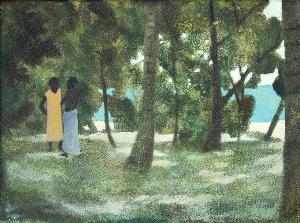Ray Austin Crooke
Ray Austin Crooke;Ray Crooke
장소: Auburn
타고난: 1922
죽음: 2015
전기:
Ray Austin Crooke AM (12 July 1922 – 5 December 2015) was an Australian artist known for his landscapes. He won the Archibald Prize in 1969 with a portrait of George Johnston. Ray Crooke is one of that generation of Australian artists who was only able to complete their art education after serving in the armed forces during World War II. As with fellow post-war artists Guy Warren and Tony Tuckson that war time experience shaped both his sensibility and his approach to art. Crooke was the second son of Gordon Crooke, an art loving accountant, and his wife Euphemia a nurse who had experienced a childhood on Aboriginal missions. After leaving school at the standard age of 15 he worked in an advertising agency while taking classes at Swinburne Technical College. In 1940 he enlisted in the Australian Army, first serving in the Victorian Scottish Regiment before being transferred to Western Australia. His unit was then transferred to northern Queensland coastal bases, a move that gave him a lifelong love of the tropics. After the War the Commonwealth Reconstruction Training Scheme enabled him to attend Swinburne Technical College and later he travelled to New Guinea, Tahiti and Fiji. In 1949 he travelled to the Torres Strait, returning to Melbourne in 1951 to marry June Bethell. A diary of his time in the Torres Strait is held by the State Library of Queensland. His portrait of the novelist George Johnston won the Archibald Prize in 1969, and the University of Queensland owns three of Ray Crooke's portrait paintings: Portrait of Xavier Herbert (1977), Portrait of Professor Emeritus Sir Zelman Cowen, (1919–2011), Vice-Chancellor 1970–1977 (1977) and Portrait of Sadie Herbert (1980). However, he is not known usually for portrait painting. He is known for serene views of Islander people and ocean landscapes, many of which are based on the art of Paul Gauguin. He was responsible for the dust-jacket illustrations for several books.

